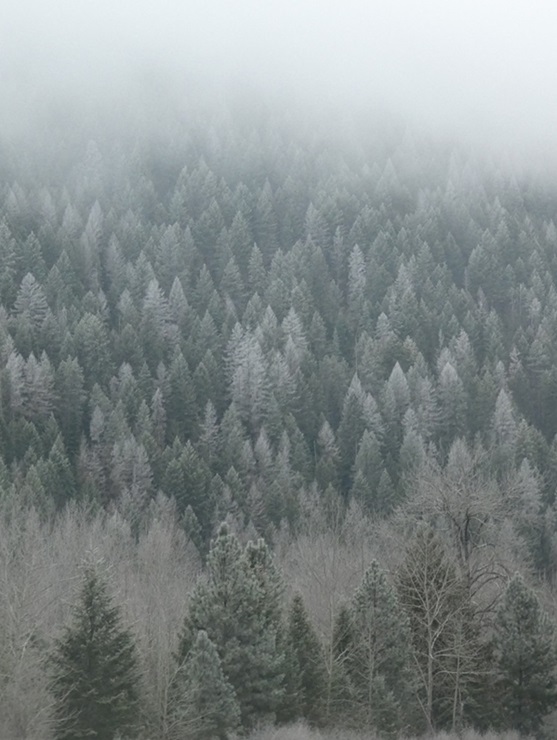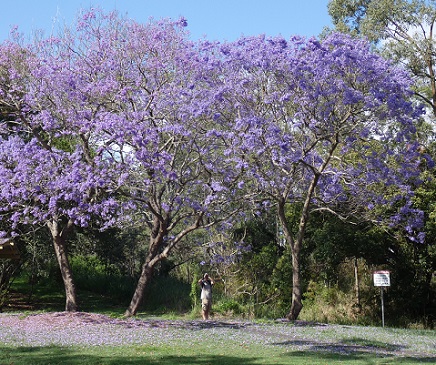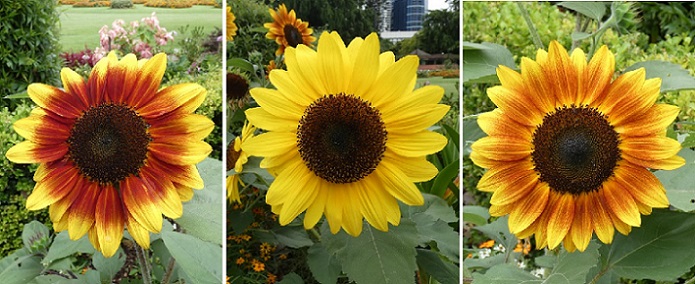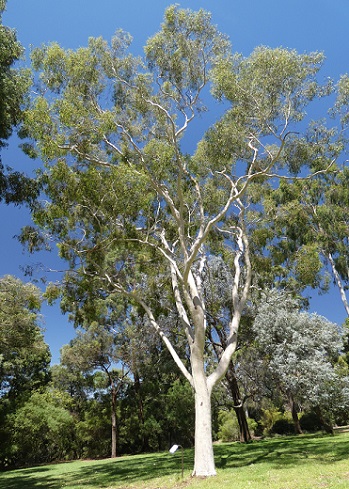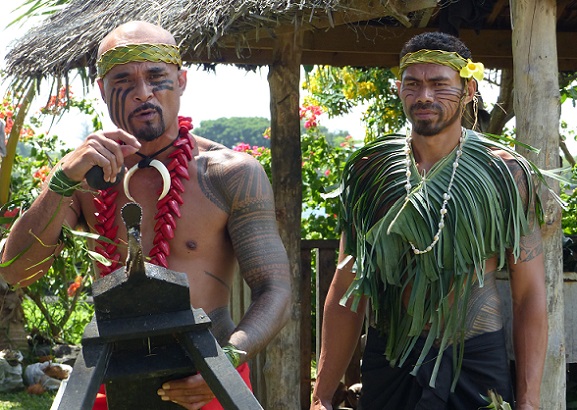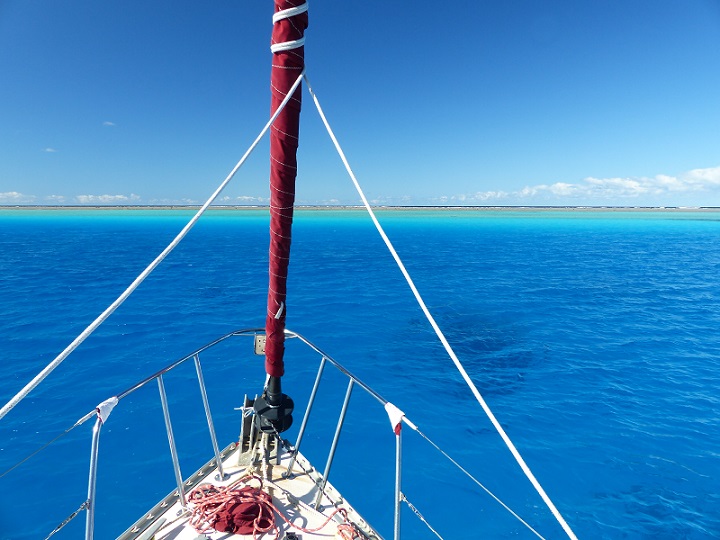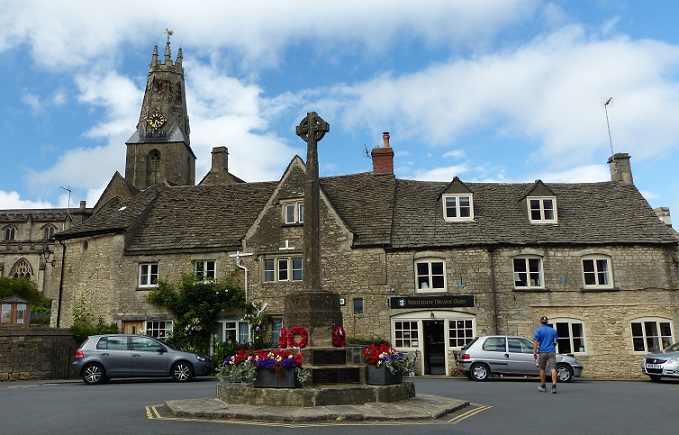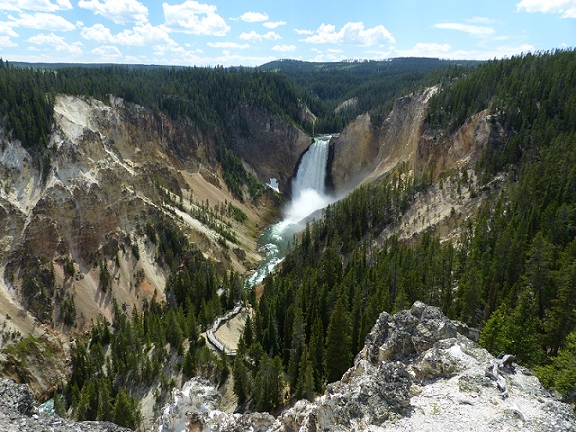
Tregoning
12 April 2024 | We are back aboard Tregoning in Mersin Marina, Mersin, Türkiye
02 April 2024 | We are in Toronto Airport, Canada: Tregoning is in Mersin Marina, Mersin, Türkiye
25 February 2024 | We are back in Gainesville, FL: Tregoning is in Mersin Marina, Mersin, Türkiye
18 February 2024 | We are in Glenwood, New Mexico: Tregoning is in Mersin Marina, Mersin, Türkiye
12 February 2024 | We are in Morro Bay, California: Tregoning is in Mersin Marina, Mersin, Türkiye
19 January 2024 | We are in Vancouver, BC Canada: Tregoning is in Mersin Marina, Mersin, Türkiye
01 January 2024 | We are in Washington State: Tregoning is in Mersin Marina, Mersin, Türkiye
15 December 2023 | We are in Minnesota: Tregoning is in Mersin Marina, Mersin, Türkiye
18 November 2023 | We are in Florida: Tregoning is in Mersin Marina, Mersin, Türkiye
29 October 2023 | We're in Florida - Tregoning is at B-dock, Mersin Marina, Mersin, Türkiye
21 October 2023 | 7 Oda Kapadokya Cave Hotel, Ürgüp, Türkiye
14 October 2023 | Hotel Aşikoğlu, Boğazkale, Türkiye
07 October 2023 | B-dock, Mersin Marina, Mersin, Türkiye
19 September 2023 | “Chez Jon & Angela”, Near Otterton, Devon, UK
14 September 2023 | Airbnb in Fortuneswell on the Isle of Portland, Dorset, UK
11 September 2023 | With Mike, Grange-over-Sands, Cumbria, UK
03 September 2023 | Ardington House, Ardington, Oxfordshire, UK
24 August 2023 | Near "Chez Joan and Peter", College of Roseisle, Moray, Scotland
11 August 2023 | Andrew's house (not exactly), Lichfield, UK
22 July 2023 | Chez Gail, near the New York Café, Budapest, Hungary
Wonderful, windless Wellington
05 January 2018 | Zealandia, Wellington, North Island, New Zealand
Photo: A kaka parrot at a feeding station in Zealandia Ecosanctuary
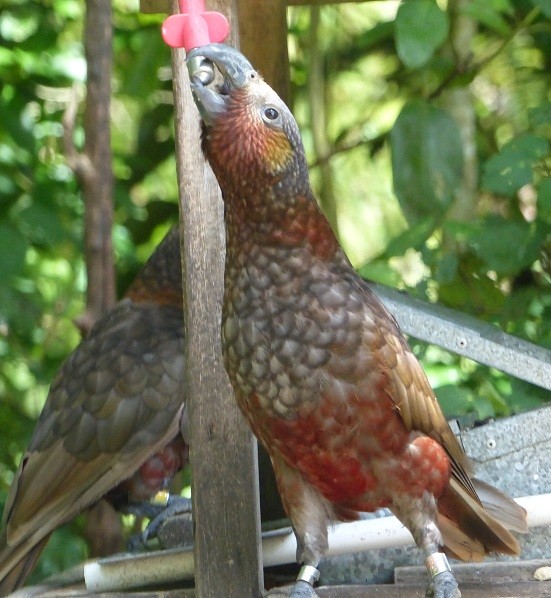
Continuing our drive south away from Mount Taranaki on Highway 3, we passed through Hawera and resisted the temptation to stop at KD's Elvis Presley Museum (think - highly obsessed fan). We did stop briefly to stretch our legs and look at a small aviary of exotic (mostly Australian) birds in a park at the entrance to the town of Wanganui on the Whanganui River (both pronounced 'wan-ga-nui').
The question of whether the name includes an "h" has been rather controversial over the years. The river and National Park names adopt the Maori spelling (with the "h") but the Pakeha (foreigners)-dominated town was originally named without the "h" because the beginning of the name was pronounced in the local Maori dialect as 'wan-ga' (meaning harbour). Elsewhere in New Zealand, 'Whanga' was pronounced 'fan-ga' (as in Whangarei). In 2009, the New Zealand Geographic Board decided that the town and region should also adopt the "h" leading to great consternation in the community. Finally, in a good example of compromise, it was decreed by the NZ Minister for Land Information that either spelling was acceptable and it was up to individuals, businesses, or other organizations to decide which spelling they would use. As the Kiwis would say, it is just as well to "get that sorted".
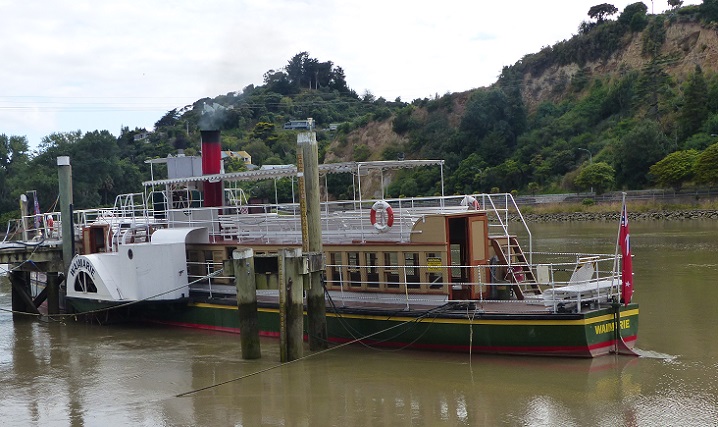
Waimarie paddle steamer on the Whanganui River in Wanganui
The river mouth had been settled by Maori tribes since 1100 AD with European settlement taking place from 1840, when sufficient land was no longer available for settlement around Wellington. The encroachment of Europeans on the Whanganui land resulted in seven years of conflict before being settled by arbitration. As the Pakeha population increased along the Whanganui River, paddle steamers were shipped in from Britain. In 1900, one of these was Waimarie which plied the river for about a half-century before she sank at her mooring in 1952. Raised and restored after 41 years underwater, Waimarie is the only remaining Whanganui River paddle steamer and she now takes people on two-hour tours of the river.

A man (left) stands next to one of the 2.4x life-size models from the Gallipoli exhibit
Since we had other priorities, we did not take a tour but we continued south, joining Highway 1 for the final approach to Wellington. It was a surprisingly sunny and calm afternoon for a city which has such a reputation for high winds. We made our way directly downtown to Te Papa Museum which we had loved so much on our previous visit to Wellington in 2015. While Randall spent most of his time on the floor that featured Maori artefacts, I revisited the Gallipoli exhibition with its series of six amazing sculptures that are 2.4 times life-size and which took 24,000 hours to create. Created by the Weta Workshop that produced the models and prostheses for films such as The Lord of the Rings, The Hobbit, and King Kong, the Gallipoli exhibits are so fantastically detailed and realistic that they are absolutely captivating. Combining their larger-than-life size and the accompanying stories of the real people that they depict, I found these models incredibly moving and sobering.
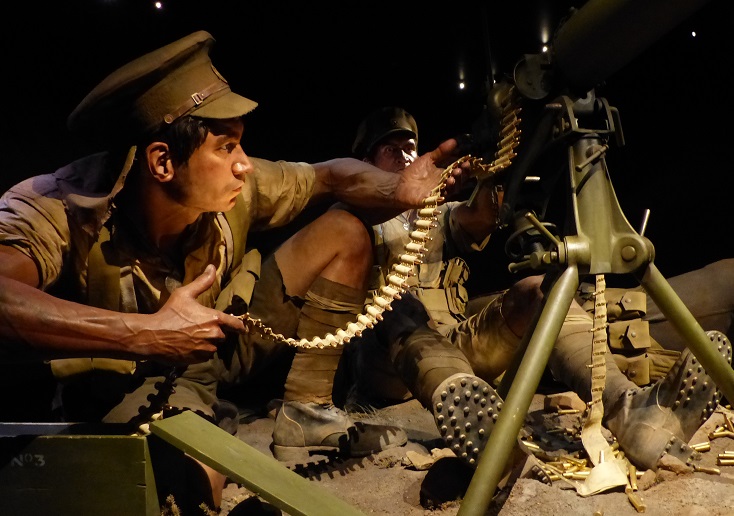
A model of the some of the Maori soldiers at Gallipoli showing the details in the arms
We could have spent many more hours in Te Papa (loosely meaning treasure box) but the unexpectedly beautiful weather drew us outside. We enjoyed walking along the popular and now-familiar waterfront (and sampling yummy ice-creams) before driving past Frank's flat. From there we eventually found the correct road to go up to the top of Mount Victoria where Frank had taken us in 2015. As then, the views over the city and large harbour from the east side of downtown were magnificent. Soon, however, we discovered that the views from the west side of the city center, also looking over the harbour but with the backdrop of the eastern Rimutaka Range, were even better.

The waterfront in Wellington with Mt. Victoria and Te Papa Museum on the right
We were treated to such vistas at the house of Nikki and Tony, two of the extended family members that we had first met at Christmas in Auckland. (If you want to get technical, Nikki is the first-cousin-once-removed to my half-uncle Frank...did that help?) Situated above the Botanical Gardens, they had chosen their split-level house for its views and, with several panoramic windows, it was immediately obvious why.

Part of the glorious view of Wellington from Nikki and Tony's house
Having, rather cheekily, invited ourselves to stay for a couple of nights within a month of our first meeting, we had an absolutely wonderful time together. Nikki and Tony were so kind, and we clearly shared similar senses of humor and viewpoints. While Nikki and I shared information about our family histories, Randall and Tony explored the love of guitars that they have in common. It made quite a big impression on Randall that there were five different styles of guitar in the house.

Tony, Nikki, and Randall enjoying a calm, warm evening on their deck
On Thursday morning (January 4th), Nikki kindly drove us to the remote and beautiful Makara Cemetery where Frank's ashes had been buried alongside his mother's remains. Although Frank's name had not yet been added to the headstone, the little patch of disturbed turf where his ashes had been interred, finally brought it home to me that a relative that I had only just got to know in the last two years had gone. But what a delight to have subsequently become so lovingly embraced by his Kiwi whanau (family).
Later in the morning, Randall and I visited the nearby Zealandia Wildlife Reserve. This 225 hectare (562 acre) ecosanctuary is located in a valley that was protected from development by steep slopes above two lakes formerly used for Wellington's water supply. The city's water now comes from reservoirs in the Hutt Valley at the north end of Wellington Harbour.
Development of the ecosanctuary was a groundbreaking conservation project that has reintroduced 18 species of native wildlife back into the area, 6 of which were previously absent from mainland New Zealand for more than a century. The reserve is surrounded by an 8.6-km long (5.4 mile) predator-proof fence that made it the world's first fully-fenced urban ecosanctuary. Traps still have to be used for small mammals because raptors (owls, hawks, and falcons) that have caught such animals outside the reserve may very occasionally drop a live pest inside the fence.

Part of Zealandia's predator-proof fence seen from outside the ecosanctuary
Randall's left knee was a bit sore so he wandered slowly along the main paths, sitting and waiting for birds to appear, while I took a 2-hour tour that lasted more than 3 hours with 9 other visitors and a guide. The tour seemed to start rather slowly with a focus on the plants but after we walked through the wetland area, we started to see plenty of birds, including some at feeders. The fauna included: Kaka parrots, stitchbirds, bellbirds, North Island saddlebacks, New Zealand pigeons, Tuis, red-crowned parakeets, North Island robins, fantails, brown teal, New Zealand scaup (ducks), and many tuatara (large native lizards which were in a large enclosure).
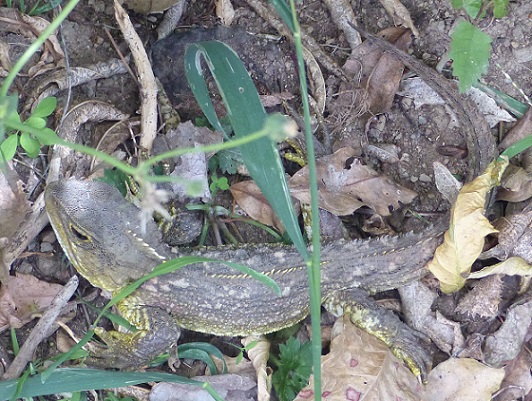
A relatively small tuatara lizard at Zealandia
The whole site was very impressive and there are many, much longer trails further up the valley providing extensive walking routes (without dogs, of course) for locals who might choose to become annual members. There were good exhibits in the visitor center and an interesting, 5-minute long introductory film that illustrates the changes in the area that occurred after the arrival of Polynesians and Europeans, and in the development of the sanctuary. The curious feature of this film was that it included no spoken or written words at all.

Restored native vegetation (apart from the Monterrey Pines on the skyline) surround the upper reservoir at Zealandia as seen from the dam
Back at Nikki and Tony's house, we saw the influence that the eco-sanctuary is having on the surrounding neighborhoods with tuis flying between trees and kaka parrots peering at the windows (less-popularly, they also sometimes hang upside-down and tap on windows). Our evening walk down to a local pub was thwarted by finding the place closed and rain starting to fall, but Tony nobly trotted back uphill to collect the car and drive us into the city center where we enjoyed a tasty Vietnamese meal. Finishing the evening with a drink at an Irish pub, we slept well that night despite some heavy rain and the first signs of gusty winds since our arrival in Wellington. Little did we realize that we were sleeping through the remnants of stormy weather that had caused havoc further north...
The question of whether the name includes an "h" has been rather controversial over the years. The river and National Park names adopt the Maori spelling (with the "h") but the Pakeha (foreigners)-dominated town was originally named without the "h" because the beginning of the name was pronounced in the local Maori dialect as 'wan-ga' (meaning harbour). Elsewhere in New Zealand, 'Whanga' was pronounced 'fan-ga' (as in Whangarei). In 2009, the New Zealand Geographic Board decided that the town and region should also adopt the "h" leading to great consternation in the community. Finally, in a good example of compromise, it was decreed by the NZ Minister for Land Information that either spelling was acceptable and it was up to individuals, businesses, or other organizations to decide which spelling they would use. As the Kiwis would say, it is just as well to "get that sorted".

Waimarie paddle steamer on the Whanganui River in Wanganui
The river mouth had been settled by Maori tribes since 1100 AD with European settlement taking place from 1840, when sufficient land was no longer available for settlement around Wellington. The encroachment of Europeans on the Whanganui land resulted in seven years of conflict before being settled by arbitration. As the Pakeha population increased along the Whanganui River, paddle steamers were shipped in from Britain. In 1900, one of these was Waimarie which plied the river for about a half-century before she sank at her mooring in 1952. Raised and restored after 41 years underwater, Waimarie is the only remaining Whanganui River paddle steamer and she now takes people on two-hour tours of the river.

A man (left) stands next to one of the 2.4x life-size models from the Gallipoli exhibit
Since we had other priorities, we did not take a tour but we continued south, joining Highway 1 for the final approach to Wellington. It was a surprisingly sunny and calm afternoon for a city which has such a reputation for high winds. We made our way directly downtown to Te Papa Museum which we had loved so much on our previous visit to Wellington in 2015. While Randall spent most of his time on the floor that featured Maori artefacts, I revisited the Gallipoli exhibition with its series of six amazing sculptures that are 2.4 times life-size and which took 24,000 hours to create. Created by the Weta Workshop that produced the models and prostheses for films such as The Lord of the Rings, The Hobbit, and King Kong, the Gallipoli exhibits are so fantastically detailed and realistic that they are absolutely captivating. Combining their larger-than-life size and the accompanying stories of the real people that they depict, I found these models incredibly moving and sobering.

A model of the some of the Maori soldiers at Gallipoli showing the details in the arms
We could have spent many more hours in Te Papa (loosely meaning treasure box) but the unexpectedly beautiful weather drew us outside. We enjoyed walking along the popular and now-familiar waterfront (and sampling yummy ice-creams) before driving past Frank's flat. From there we eventually found the correct road to go up to the top of Mount Victoria where Frank had taken us in 2015. As then, the views over the city and large harbour from the east side of downtown were magnificent. Soon, however, we discovered that the views from the west side of the city center, also looking over the harbour but with the backdrop of the eastern Rimutaka Range, were even better.

The waterfront in Wellington with Mt. Victoria and Te Papa Museum on the right
We were treated to such vistas at the house of Nikki and Tony, two of the extended family members that we had first met at Christmas in Auckland. (If you want to get technical, Nikki is the first-cousin-once-removed to my half-uncle Frank...did that help?) Situated above the Botanical Gardens, they had chosen their split-level house for its views and, with several panoramic windows, it was immediately obvious why.

Part of the glorious view of Wellington from Nikki and Tony's house
Having, rather cheekily, invited ourselves to stay for a couple of nights within a month of our first meeting, we had an absolutely wonderful time together. Nikki and Tony were so kind, and we clearly shared similar senses of humor and viewpoints. While Nikki and I shared information about our family histories, Randall and Tony explored the love of guitars that they have in common. It made quite a big impression on Randall that there were five different styles of guitar in the house.

Tony, Nikki, and Randall enjoying a calm, warm evening on their deck
On Thursday morning (January 4th), Nikki kindly drove us to the remote and beautiful Makara Cemetery where Frank's ashes had been buried alongside his mother's remains. Although Frank's name had not yet been added to the headstone, the little patch of disturbed turf where his ashes had been interred, finally brought it home to me that a relative that I had only just got to know in the last two years had gone. But what a delight to have subsequently become so lovingly embraced by his Kiwi whanau (family).
Later in the morning, Randall and I visited the nearby Zealandia Wildlife Reserve. This 225 hectare (562 acre) ecosanctuary is located in a valley that was protected from development by steep slopes above two lakes formerly used for Wellington's water supply. The city's water now comes from reservoirs in the Hutt Valley at the north end of Wellington Harbour.
Development of the ecosanctuary was a groundbreaking conservation project that has reintroduced 18 species of native wildlife back into the area, 6 of which were previously absent from mainland New Zealand for more than a century. The reserve is surrounded by an 8.6-km long (5.4 mile) predator-proof fence that made it the world's first fully-fenced urban ecosanctuary. Traps still have to be used for small mammals because raptors (owls, hawks, and falcons) that have caught such animals outside the reserve may very occasionally drop a live pest inside the fence.

Part of Zealandia's predator-proof fence seen from outside the ecosanctuary
Randall's left knee was a bit sore so he wandered slowly along the main paths, sitting and waiting for birds to appear, while I took a 2-hour tour that lasted more than 3 hours with 9 other visitors and a guide. The tour seemed to start rather slowly with a focus on the plants but after we walked through the wetland area, we started to see plenty of birds, including some at feeders. The fauna included: Kaka parrots, stitchbirds, bellbirds, North Island saddlebacks, New Zealand pigeons, Tuis, red-crowned parakeets, North Island robins, fantails, brown teal, New Zealand scaup (ducks), and many tuatara (large native lizards which were in a large enclosure).

A relatively small tuatara lizard at Zealandia
The whole site was very impressive and there are many, much longer trails further up the valley providing extensive walking routes (without dogs, of course) for locals who might choose to become annual members. There were good exhibits in the visitor center and an interesting, 5-minute long introductory film that illustrates the changes in the area that occurred after the arrival of Polynesians and Europeans, and in the development of the sanctuary. The curious feature of this film was that it included no spoken or written words at all.

Restored native vegetation (apart from the Monterrey Pines on the skyline) surround the upper reservoir at Zealandia as seen from the dam
Back at Nikki and Tony's house, we saw the influence that the eco-sanctuary is having on the surrounding neighborhoods with tuis flying between trees and kaka parrots peering at the windows (less-popularly, they also sometimes hang upside-down and tap on windows). Our evening walk down to a local pub was thwarted by finding the place closed and rain starting to fall, but Tony nobly trotted back uphill to collect the car and drive us into the city center where we enjoyed a tasty Vietnamese meal. Finishing the evening with a drink at an Irish pub, we slept well that night despite some heavy rain and the first signs of gusty winds since our arrival in Wellington. Little did we realize that we were sleeping through the remnants of stormy weather that had caused havoc further north...
Comments
| Vessel Name: | Tregoning |
| Vessel Make/Model: | Morgan Classic 41 |
| Hailing Port: | Gainesville, FL |
| Crew: | Alison and Randall |
| About: | We cast-off from Fernandina Beach in north Florida on 1st June 2008 and we have been cruising on Tregoning ever since. Before buying Tregoning, both of us had been sailing on smaller boats for many years and had worked around boats and water throughout our careers. |
| Extra: | “Tregoning” (rhymes with “belonging”) and is a Cornish word (meaning “homestead of Cohnan” or “farm by the ash trees”) and was Alison's mother’s middle name. Cornwall is in southwest England and is where Alison grew-up. |
Tregoning's Photos - Main
 |
Extra photographs from our three-week campervan tour of the South Island from November 15th to December 5th 2015
217 Photos
Created 4 January 2016
|
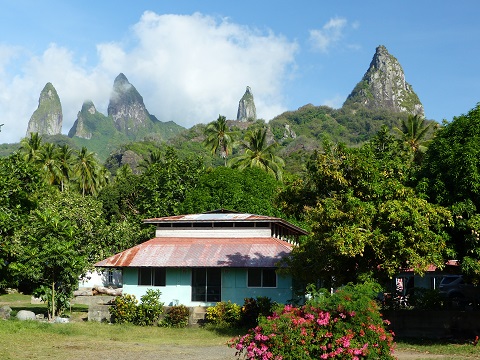 |
Random pictures from our month spent on the islands of Hiva Oa, Tahuata, Ua Pou, and Nuku Hiva
45 Photos
Created 18 July 2015
|
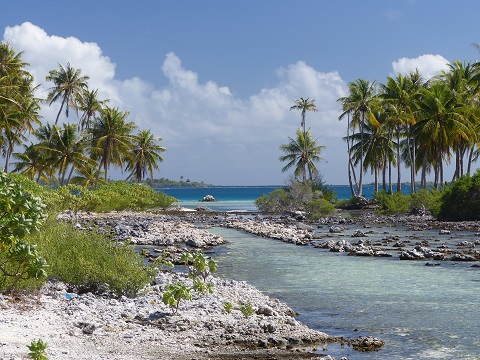 |
Random pictures from our month spent in 4 Tuamotu Atolls; Ahe, Fakarava, Tahanea, and Toau
32 Photos
Created 1 July 2015
|
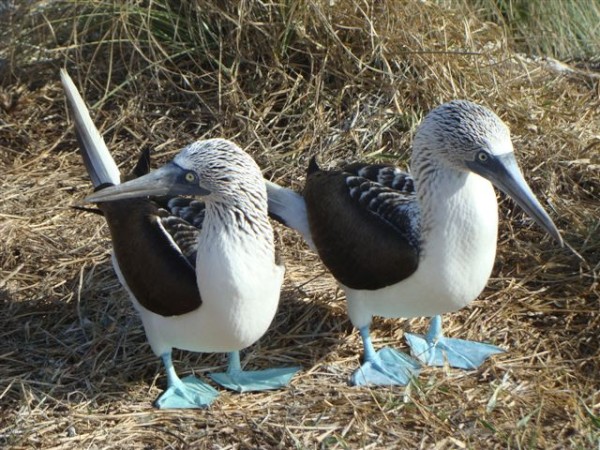 |
Some of the birds, fish, reptiles, and mammals (and others) that we have seen in Mexico
74 Photos
Created 5 May 2014
|
Tregoning

Who: Alison and Randall
Port: Gainesville, FL
